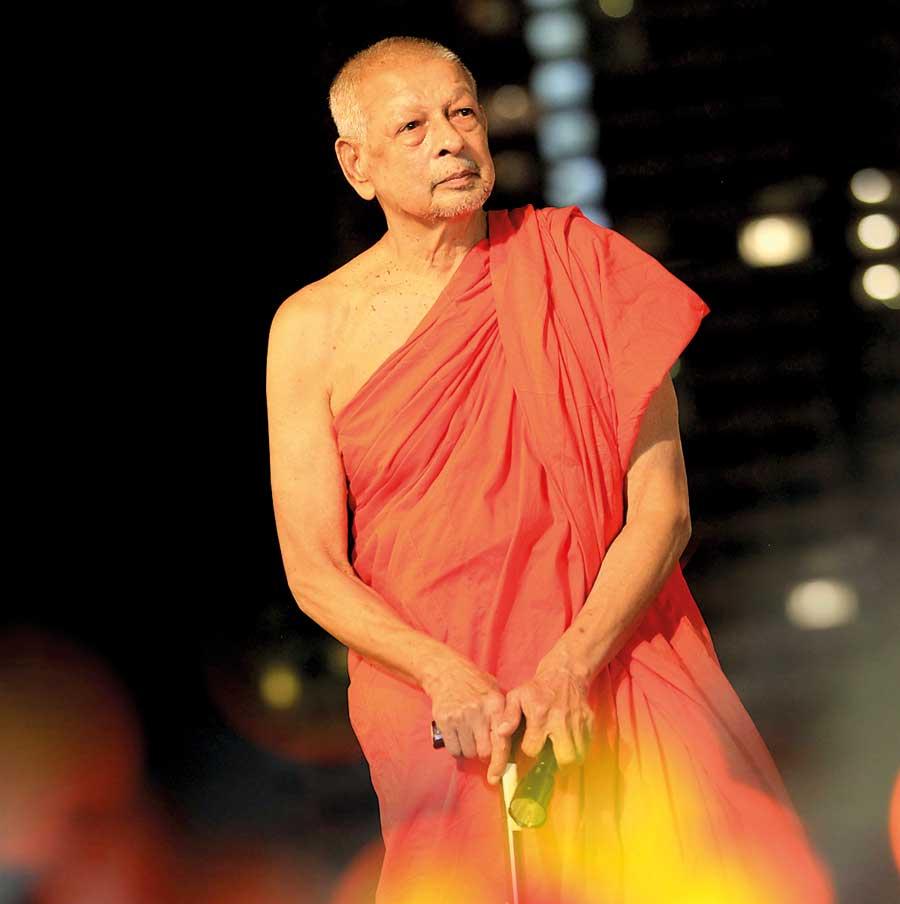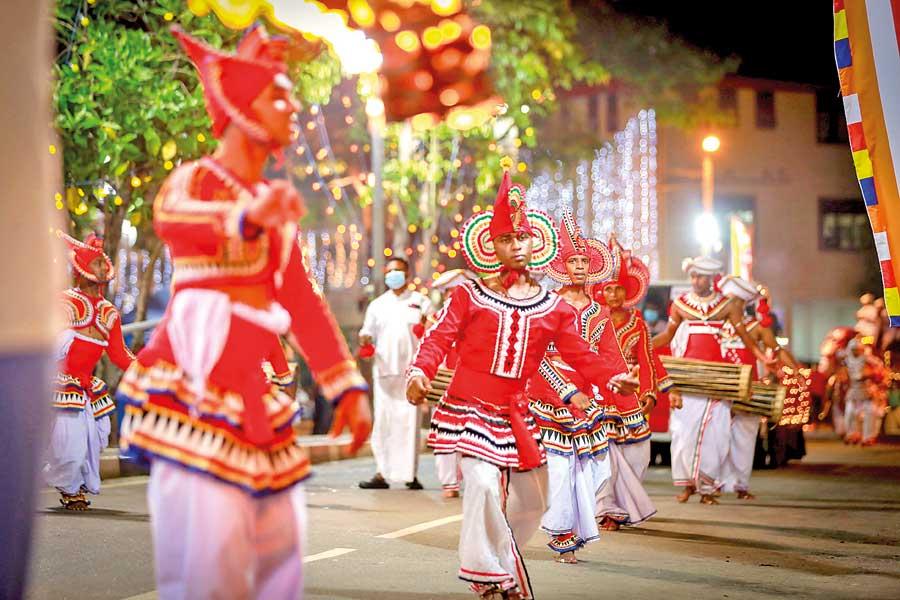23 Feb 2024 - {{hitsCtrl.values.hits}}

Leadership qualities, a responsible attitude and a great personality are inherent characteristics possessed by Most Venerable Galaboda Sri Gnanissara Maha Nahimi, also known as Podi Hamuduruwo
Ven. Dr. Kirinde Assaji with the aid of the community of resident monks and lay devotees have successfully organised the upcoming Nawam Maha Perahera
At the core of the The Nawam Maha Perahera of Gangaramaya which is held annually lies the offering of homage to the noble triple gem, the Buddha, Dhamma and Sangha
Gangaramaya Maha Viharaya situated in the heart of Colombo has played a preeminent role in society; memories of which will be evoked in any reader. On one hand, the grandest of Buddhist festivals, the Navam Maha Perehara (Pageant) and the Buddha Rashmi Vesak Zone, provide a priceless opportunity for the communities to unite in celebration. On the other hand, the Jinarathana Technical College and the Kataragama Retirement Hall, offer a continuous service to society. The strength behind these accomplishments is the Chief Incumbent of the Gangaramaya Maha Viharaya, the Most Venerable Galaboda Sri Gnanissara Maha Nahimi, who is fondly known among the lay followers as ‘Podi Hamuduruwo’. Moreover, the unwavering support given by the community of monks- led by the Deputy Incumbent of the Gangaramaya Maha Viharaya, Ven. Dr. Kirinde Assaji- has tremendously facilitated its journey to success. Gangaramaya Navam Maha Perahera, which is an illustrious procession depicting Sri Lankan heritage, will be held on February 23 and 24.
hand, the grandest of Buddhist festivals, the Navam Maha Perehara (Pageant) and the Buddha Rashmi Vesak Zone, provide a priceless opportunity for the communities to unite in celebration. On the other hand, the Jinarathana Technical College and the Kataragama Retirement Hall, offer a continuous service to society. The strength behind these accomplishments is the Chief Incumbent of the Gangaramaya Maha Viharaya, the Most Venerable Galaboda Sri Gnanissara Maha Nahimi, who is fondly known among the lay followers as ‘Podi Hamuduruwo’. Moreover, the unwavering support given by the community of monks- led by the Deputy Incumbent of the Gangaramaya Maha Viharaya, Ven. Dr. Kirinde Assaji- has tremendously facilitated its journey to success. Gangaramaya Navam Maha Perahera, which is an illustrious procession depicting Sri Lankan heritage, will be held on February 23 and 24.
The continuous commitment of the student monks with the blessing of Podi Hamuduruwo has led to numerous achievements. Among these achievements were the launch of ‘Haritha TV’ channel, promoting self-sufficiency through agriculture that Podi Hamuduruwo had constantly envisaged for the betterment of the society and the declaration of the Gangaramaya Maha Viharaya as a place of worship by Hon. Ranil Wickramasinghe. As such, Gangaramaya has shown excellence in achieving various goals.
At present, Gangaramaya Maha Vihara is preparing to enliven the city of Colombo with the cultural festival ‘Navam Maha Perahera’ bringing splendour, majesty and enchantment. The Navam Maha Perahera has become an iconic symbol of Sri Lanka, revered locals as well as foreigners from over the world. It is also one of the main reasons for the greater influx of visitors during the month of February, becoming one of the main perahera festivals attracting tourists to Sri Lanka. In general, It has become a cultural festival cherished by many foreign visitors over the past decades.
It gives a great pleasure in witnessing the ability of the Nawam Maha Perahera to revive and celebrate the strength and pride of the Sri Lankan heritage. In the midst of a severe economic crisis, it is an enormous challenge to hold a procession at a grand scale. However, by overcoming all such adversities, Ven. Dr. Kirinde Assaji with the aid of the community of resident monks and lay devotees have successfully organised the upcoming Nawam Maha Perahera.
In considering the history related to Buddhist processions, it is thought to extend as far back as the era of Gautama Buddha. Although it had been a cultural element even before the birth of the Buddha, it gained a greater significance following the connection with Buddhism.
According to the Buddhist chronicles, the queen Maha Maya left Kapilavatthu heading towards the home of her parents situated in Devadaha, in a beautiful procession for the birth of Prince Siddhartha Gautama. The route was adorned with magnificent flags. A large entourage had travelled along with the queen in order to perform various tasks such as reciting songs of blessings. It is said that the Bodhisatta was born in the course of the journey to Kapilavatthu at the Sala Grove of Lumbini.
Furthermore, subsequent to Tathaagata Parinirvana, many devotees including the households of both the Royals and the Brahmins had attended to pay homage by making offerings for seven days. On the seventh day, the body of Gautama Buddha was wrapped in alternating layers of five hundred pieces each of new cloth and cotton wool, finally placed in a casket anointed with fragrant oil. A procession was held and with due honour the body of Gautama Buddha was cremated within a scented pyre.
During the reign of king Dhammasoka, the devotees had held processions in the sacred sites of Pataliputra, Isipatana, Lumbini, Sanchi and Kusinara based on Buddhist religious rituals.
The concept of Perahera with its connection to Buddhism, is believed to have emerged within the Sri Lankan culture following the arrival of Arahant Mahinda. Mahavamsa records that the sacred collar bone relic of Gautama Buddha was carried in a procession for the relic enshrinement ceremony in the Thuparamaya stupa. It has been recorded in history that the sapling from the sacred Jaya Sri Maha Bodhi tree which was brought to Sri Lanka by Sanghamitta Therini was taken in a grand procession from Dambakola Patuna to Anuradhapura, in which the entire route had been beautifully decorated with flags. Moreover, the Dalada Perahera is believed to have begun as a form of offering of homage when the sacred Tooth relic of Gautama Buddha was brought to Sri Lanka. There are historical records indicating that the sacred tooth relic received royal patronage. Even to date, it is customary to perform the rituals and processions connected with the Tooth relic.
Accordingly, a procession can be considered as a supreme form of offering which is deeply ingrained in the minds of Buddhist devotees since the era of the Buddha. A Buddhist procession is not merely an elegant carving which highlight colourful cultural elements. It is an act of worship based on a series of Buddhist events. There is a comparable basic core connected to every procession performed in the temples of Sri Lanka.
At the core of the The Nawam Maha Perahera of Gangaramaya which is held annually lies the offering of homage to the noble triple gem, the Buddha, Dhamma and Sangha. Furthermore, the bestowal of the titles of chief disciples to both Sariputta thera and Moggallana thera is also commemorated through the Navam Maha Perahera. Hence, regardless of consistently being referred to as the great cultural festival and the colourful procession of Colombo, it is worth thinking about it as an offering to the noble triple gem highlighting the essence and purpose of Buddhism.
Since the beginning, Gangaramaya Maha Viharaya has been committed to conduct the Nawam Maha Perahera in the grandest manner. Podi hamuduruwo intended to fulfil multiple functions with the aid of the Nawam Maha Perahera. According to Podi Hamuduruwo, the unique crafts of the performers can be preserved for generations only by the act of conducting the processions. Those observing the way in which a procession is organised will be encouraged in order to be committed to maintain and continue to preserve these crafts for future generations. Thus, the practicality of each event organised by Podi Hamuduruwo can be clearly understood upon deep examination of the underlying purpose.
At a tender age of 16, Podi Hamuduruwo accepted the duty of managing the Gangaramaya Maha Viharaya. Leadership qualities, responsible attitude and a great personality were inherent characteristics possessed by Podi Hamuduruwo along with a good fortune from a much younger age. Within the matter of a short period of time, Podi Hamuduruwo built a good rapport with his superior Ven. Vachissara as well as the lay devotees.
Since then, Podi Hamuduruwo has secured Gangaramaya Maha Viharaya from any downfalls and brought it into the prestigious state seen at present.
Gangaramaya Navam Perahera is a spectacular festival consisting of variety of traditional performances. It comprises of up country, low country and Sabaragamuwa dance and druming styles as well as several unique elements that would not be seen in any other perahera procession, exquisitely portraying the magnificence and excellence of local art and craftsmanship. Another special component is the long line of Maha Sangha parading the Navam Maha Perahera.
With the full blessings of the Most Venerable Galboda Sri Gnanissara Maha Nahimi, the community of monks led by the Deputy Incumbent of the Gangaramaya Maha Viharaya, Ven. Dr. Kirinde Assaji Thero, the Gangaramaya Dayaka Sabha along with foreign and local philanthropists and several government and private institutions have contributed to make the Nawam Maha Perahera a great success.
(This article written by the author was
translated to English by Pooja Ranasinghe)

The Navam Maha Perahera has become an iconic symbol of Sri Lanka, revered locals as well as foreigners from over the world
01 Jan 2025 35 minute ago
01 Jan 2025 1 hours ago
01 Jan 2025 2 hours ago
01 Jan 2025 5 hours ago
01 Jan 2025 5 hours ago